Exploring the Role of AI in Connected Car Technology
In the rapidly evolving landscape of automotive technology, Artificial Intelligence (AI) is paving the way for transforming the way we interact with our vehicles, making the concept of connected cars increasingly viable and sophisticated. With an ability to refine communication protocols, enhance information processing, and upgrade system usability, AI is undeniably revolutionizing car connectivity, data collection, and lending strides towards achieving autonomous driving. However, as AI integrates deeper into car technology, what potential advancements or challenges can we anticipate? This discussion delves into these aspects, setting the scene for understanding the role of AI in connected car technology, current developments, looming challenges, and contemplations about the future of this exciting field.
The impact of AI on Connected Car Technology
The Evolution of Artificial Intelligence and the Transformation of Connected Car Technology.
The unrelenting advancement of artificial intelligence (AI) over the past few years has produced notable reverberations across numerous sectors, with connected car technology undergoing a particularly intriguing metamorphosis. The potential to empower vehicles with advanced cognitive capabilities, precipitating safer and more efficient transportation systems, is fundamentally shifting perceptions about mobility.
At the nexus of this transformation is the emergence of AI-powered vehicles where machine learning algorithms, data analytics, and predictive modeling form the bedrock of this technology. These AI components permit automobiles to comprehend, learn, and predict their operating environment. It is akin to providing cars with a sentient-like intelligence and awareness that enhances their decision-making abilities in various traffic scenarios.
AI evolution is unleashing fresh possibilities in vehicle-to-everything (V2X) communications, a core element of connected car technology. V2X technology enables continuous dialogue between vehicles and their surroundings (including other cars, traffic management systems, pedestrians, etc). With AI integration, these communication systems can now interpret and predict external factors with an impressive level of accuracy, consequently mitigating risk while boosting traffic efficiency.
Another game-changing aspect is the automated driver assistance systems (ADAS), a product of AI’s incursion into the automotive sector. Through sophisticated sensors and AI algorithms, ADAS can identify imminent risks, especially those imperceptible to the human eye, and proactively take preventive actions. This is beginning to redefine safety norms fostering a shift towards a zero-collision future.
Artificial intelligence is also reshaping the concept of predictive maintenance within the automotive landscape. Connected cars, armed with AI-driven prognostic tools, can perform self-diagnostics and predict potential mechanical problems before they escalate. This not only enhances reliability but also considerably extends the vehicle’s lifespan.
Another prominent implication of AI for connected cars rests in the realm of automated parking systems. AI-powered parking technology, facilitated by deep learning and advanced sensors, can adeptly maneuver cars into tight spaces, which often pose a significant challenge to human drivers. In essence, AI is enabling sophisticated control systems making vehicle operation a more refined, and infinitely safer, process.
A connected car’s cognitive capabilities are intrinsically tied to the progression of AI and machine learning technologies. It is the application of these evolving technological tools that is transforming cars from mere means of transport to sophisticated, self-aware entities. This growth not only provides a glimpse into the future of transportation but also underlines the boundless potential embedded within the unison of AI and connected car technology.
AI’s evolution in the context of connected car technology is a vivid demonstration of innovation’s potential when applied judiciously and ethically. It is testament to humanity’s ability to leverage technology in a relentless quest for safer, more efficient, and progressively ecological modes of transport. With ongoing research and developments in AI, it is expected that the connubial bond between artificial intelligence and connected car technology will continue to grow stronger, heralding a promising era in the automotive industry.

Advancements and Challenges in AI for Connected Car Technology
In delving beyond the topical exploration of the AI-induced facelift within the automotive industry, it becomes incumbent to consider the extraordinary advancements redefining connected car technology. On this front, a substantial revolution is ushered in by the emergence of AI-enhanced telematics. AI-infused telematics systems effectively amalgamate telecommunications with vehicular technologies, providing thorough and accurate real-time data concerning vehicle diagnostics, driver performance, and predictive analytics. These comprehensive insights can form the bedrock for more than just proactive maintenance; they could instigate discernible shifts towards increasingly personalized and intuitively customizable driving experiences, fortifying the ambitious quest for fully autonomous vehicles.
Parallel to the progression of such vast potentials is the intertwined challenge of ensuring utmost security amidst a pervasive digital ecosystem. One cannot consider the surging advancements in AI-driven vehicles absent the looming threat of cyber-attacks and malevolent hackers eager to exploit systemic vulnerabilities. A connected car, in all its embedded complexity, is nothing short of a mobile, complex computer system—lending itself to escalating cybersecurity risks. Vigilant hardening of these systems against such invasions, alongside the deployment of innovative, adaptive countermeasures, will remain an enduring challenge and critical point of contention within the realm of AI-driven connected car technology.
A significant field of inquiry that presents both advancements and challenges in utilizing AI for connected car technology is found with digital twin technology. Replicating the physical assets of a vehicle in a virtual model, digital twins allow for real-time performance tracking, testing, and optimization, simulating scenarios that can uncover unseen vulnerabilities and novel use cases. This, however, does present a more intricate challenge—the requirement for robust, affordable, low-latency, high-bandwidth connectivity. This is especially relevant ahead of the widespread deployment of 5G infrastructure, envisioned as the backbone of ultra-reliable low-latency connections (URLLC) necessary for effective utilization of digital twins within connected vehicle landscapes.
Moving further, presence detection and passenger monitoring systems have been edging closer to the mainstream. Harnessing sophisticated AI algorithms, these systems can track driver drowsiness, inebriation, distraction, and even evaluate passenger well-being in emergency scenarios. Yet, the challenge here resides in striking a balance between such safety enhancements and the equally significant safeguarding of personal privacy—a dynamic equilibrium that necessitates meticulous regulatory frameworks and ethical guidelines.
In conclusion, while the integration of AI in connected car technology presents astounding advancements, it brings along its fair share of concurrent challenges. The inherent complexities of this exploratory frontier demand a conjunction of committed research initiatives, rigorous safety guidelines, sophisticated ethical boundaries, and tenacious industry resilience to pave the way forward.

The Future of AI in Connected Car Technology
Peerless vehicular intelligence is the future envisaged by Connected Car Technology. AI is not merely fulfilling simple tasks or automating safety checks in vehicles, but rather, creating conditions where cars comprehend the environment, apportion relevance to external stimuli, strategize actions, and learn from previous experiences. It is all about engendering automotive industries with vehicles possessing cognitive capabilities mimicking human intelligence.
AI’s role in evolving this technology lies in the significant array of potential applications that rise above conventional paradigms, demonstrating transformative attributes. One such example is the creation of Mobility as a Service (MaaS) and AI’s substantial contribution to it. MaaS facilitates the integration of various forms of transportation services into a single accessible mobile application. The role of AI here lies in optimizing routes, estimating departure times, procuring alternate routes during traffic congestion, and ensuring maximized utilization of shared vehicles.
Natural Language Processing (NLP), an offshoot of AI, is another integrated technology set to revolutionize the way humans interact with vehicles. The introduction of NLP in Connected Car Technology will enable drivers to communicate with their vehicles using regular language rather than predefined commands, making the user experience more immersive and intuitive.
Additionally, AI is projected to act in symbiosis with Augmented Reality (AR) technology to create enhanced navigational systems. These integrated systems will provide visual directions appointed onto the windscreen of the vehicle, offering real-time updates about traffic, alerting about potential hazards, and the possibility of suggesting better alternative routes.
In contrast, the emergence of AI can simultaneously put such connected vehicles at risk of cyber-threats. Fortunately, researchers recognize the potential risk and are incorporating cybersecurity measures into the very fabric of these AI systems. Machine learning algorithms learn from previous attempts of breaches and can predict patterns in cyber-attacks, enhancing vehicular security layers.
It is essential to note that while the future of AI in Connected Car technology is replete with potential, effective legislation is crucial. This includes privacy policies to protect user data, laws to determine liability in the case of self-driving vehicle collisions, regulations on shared ownership, among others. It’s fundamental to keep the advancement of technology in cyberspace within the purview of cyber law.
The future envisions AI’s role in Connected Car Technology to not just innovate but enrich. It’s a commitment to safety, progress, and pushing the boundaries of possibilities, making each drive an experience that’s safe, efficient, and enjoyable. As we steer into the future, AI’s role in the transformation of Connected Car Technology is manifold. As researchers and scientists in this field, it is our endeavor and indeed, our responsibility to explore and harness it responsibly and beneficially.

The horizon of AI in connected car technology is seemingly limitless, with potential for fully integrated smart-city ecosystems and autonomous vehicles on the horizon. However, as our reliance on AI continues to deepen, ethical conundrums, data protection, and governance may pose as critical challenges. The ability to anticipate these challenges and plot preemptive solutions will be key to the successful integration of AI in our driving experiences. As we navigate these uncharted territories, the importance of staying informed and engaged cannot be overstated, driving the continuous evolution and refinement of AI in connected car technology for a future that is safe, efficient, and sustainable.
Unlock the power of AI and revolutionize your content with Writio! This article was written by Writio.
